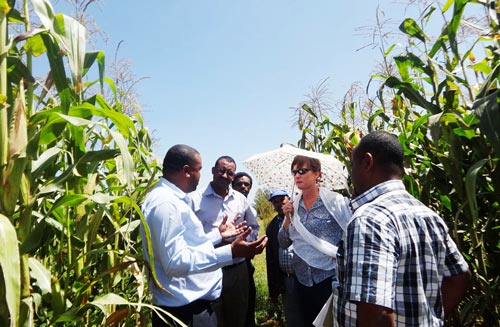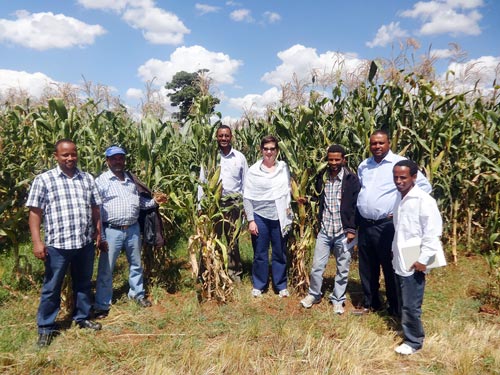By Dagne Wegary/CIMMYT
The Australian Ambassador to Ethiopia paid her first visit to a CIMMYT program this month and commended efforts to improve livelihoods in resource-poor rural households.
On her 7 November visit, Ambassador Lisa Filipetto learned about activities under the Sustainable Intensification of Maize-Legume Systems for Food Security in Eastern and Southern Africa (SIMLESA) program, which have been implemented in different parts of Ethiopia since 2010. She visited SIMLESA sites in northwest Ethiopia, where work is conducted by the Amhara Regional Agricultural Research Institute (ARARI). Maize-based farming in the region is characterized by unsustainable production systems, including monocropping, repeated tillage and residue removal. SIMLESA promotes new crop varieties and production practices such as intercropping, maize-legume rotations, reduced tillage and year-round residue coverage. Farmers who have traditionally monocropped maize appreciate the new practices, which help them increase harvests while replenishing soil fertility.

Filipetto was accompanied by scientists from CIMMYT-Ethiopia and the Ethiopian Institute of Agricultural Research (EIAR), SIMLESA partners. Dr. Biru Yitaferu, director general of ARARI, and Likawent Yeheyis, director of livestock research for ARARI, welcomed the visiting team. Yitaferu highlighted ARARI’s managerial structure, mandates, missions and resource capacities while Yiheyis presented an overview of SIMLESA work in the region.
Presentations showcased the program’s extensive research and development activities including conservation agriculture-based exploratory trials; farmer participatory variety selection (PVS) for maize, grain legumes and forage and fodder varieties; and technology implementation in South Achefer and Jabitenan districts, which is aided by ARARI researchers and district agricultural offices.

Filipetto visited a SIMLESA site hub in South Achefer and saw activities of the Abchikli Farmers’ Training Center on conservation agriculture-based intercropping, as well as PVS trials with hybrid and open-pollinated maize and varieties of sweet lupine – a multi-purpose legume crop traditional in Ethiopia. Four of the sweet lupine varieties in the trials are under the final stage of evaluation for future commercial release. Yeheyis said Amhara’s agriculture bureau will include conservation agriculture, maize-legume intercropping and maize-fodder/forage relay cropping in its regular extension program. This will contribute significantly to adoption of the technologies by a wider range of farming communities in the region, according to Yeheyis.
At the end of her visit, Filipetto expressed great interest in partnering with CIMMYT to improve livelihoods in the region. SIMLESA in Ethiopia is funded by Australian Center for International Agricultural Research (ACIAR) and Australian Agency for International Development (AusAID).
 Innovations
Innovations